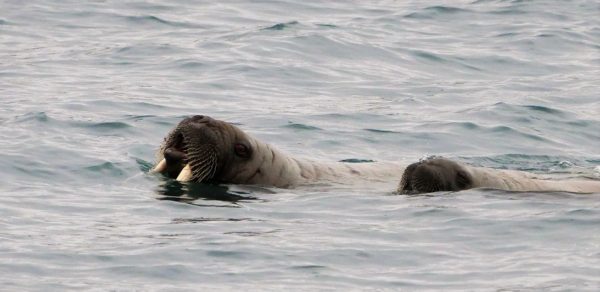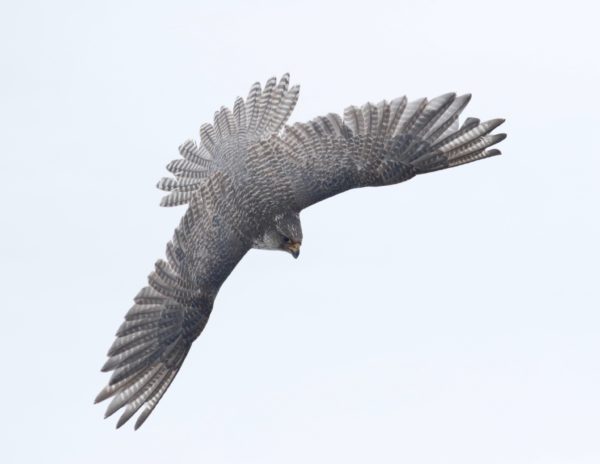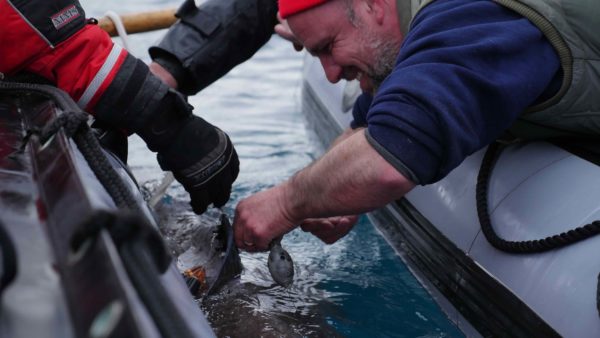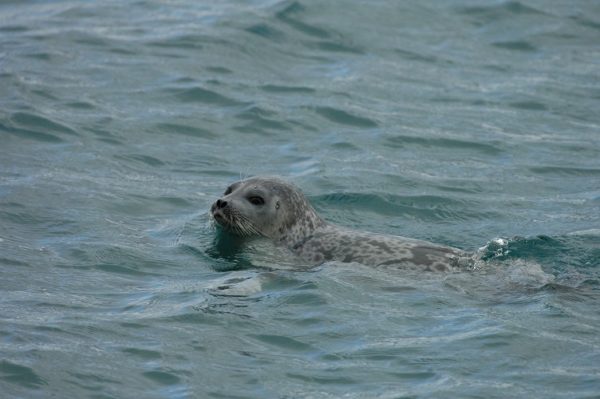Curious seal, ancient sharks arrive at Narwhal Camp
Though we refer to it affectionately as Narwhal Camp, the research project underway in Tremblay Sound, Nunavut, encompasses so much more. In addition to using advanced technology to uncover narwhal secrets, the research team is also gathering crucial data on seabirds, Greenland sharks, ringed seals and more. Though Week Three was low on narwhals, other northern wildlife gave researchers – including WWF biologists Tom Arnbom and Melanie Lancaster – plenty to write home about. (To find out what other wildlife the team has encountered, read updates from Week One and Week Two at camp.)
Aug. 4: Tooth walkers
One of the Arctic’s big five is the walrus. At least five times bigger than all other Arctic seals, its tusks and bristly moustache make it instantly recognizable. As the ice in Tremblay starts to open up, much to our delight we are paid a visit by two walruses – a mother and her young.
It is the first time since this science program started that walruses have been spotted at Tremblay – a very rare treat for us all. At the call of “WALRUS,” all tents are emptied in seconds and there is much excited chatter and dashing about for cameras and binoculars as they cruise past camp, obviously checking us out.
Walruses were commercially hunted to near extinction historically but have been slowly bouncing back in recent times. Now there are about 25,000 in the north Atlantic. These fin-footed giants dine in shallow waters and can eat several thousand clams per day. Superbly adapted, they have sensitive moustaches to find their prey and they use their tongues and lips to suck the meat from the shells like powerful vacuum cleaners. As the pair take a last breath before they dive under the water, we catch a glimpse of their enormous bodies – a truly awesome sight!
August 5: Gyrfalcon
As Inuit researcher Jobie Atagootak gives WWF’s Tom Arnbom a lesson on edible Arctic plants, suddenly they hear a chorus of alarm calls from a group of common ringed plovers nearby. Looking up, they see it. A gyrfalcon zooms by above them, quick as a flash.
The gyrfalcon, known by the Inuit as the kiggaviarjuk, is among the toughest birds in the world and one of only a few species that thrives in the harsh Arctic winter. This far north, many have almost white plumage but this one was darker brown.
Normally gyrfalcons feed on ptarmigans – similar to grouse and a bit like the “chicken” of the Arctic. But here in Tremblay, there are not many ptarmigans around so the gyrfalcons go for any bird they can catch. This includes common ringed plovers, which explains the loud distress peeps heard by Tom and Jobie just before this fantastic aerial predator appeared. This rare gyrfalcon sighting is added to the data log of seabirds being collected as part of the science program at Tremblay.
Aug. 5: The ancient Greenland shark
Large dark shadows patrol the depths of Tremblay Sound waiting for something to feast on. Equipped with hundreds of razor-sharp teeth, the Greenland shark is the most common large predator of the Arctic. Nigel Hussey from Windsor University is the leading world expert on these sharks that live life in the “slow lane.”
Greenland sharks continuously surprise us as we learn more about them. These fantastic fish are the grandfathers of the Arctic, reaching over 400 years old and about the same size as white sharks. Close to 100 per cent of all Greenland sharks are partially blind because of a parasite that infests their eyes. Exactly how they find and catch their prey is still a mystery but is most likely by “smell.”
An important part of the research in Tremblay is to find out how Greenland sharks and narwhals interact with each other and the Tremblay Sound ecosystem. Sharks are equipped with electronic tags so Nigel and his team can follow their daily lives and uncover more about these enigmatic and fascinating predators.
Aug. 12: A curious seal
Mother Nature is still testing the patience of Narwhal camp team: When it’s not the ice holding us from setting the narwhal net, it’s the wind and the waves. But today, she decided to send us some very exciting stuff instead: The team managed to capture one of the curious ringed seals that were hanging around the camp.
While a part of the team took care of the seal, Andrew Jaworenko, one of the inuit researchers, was able to put tags on it that will record the seal’s location and movement as well as some oceanographic measurements. This capture is the starting point of a seal monitoring program rooted in the community of Mittimatalik (Pond Inlet).





